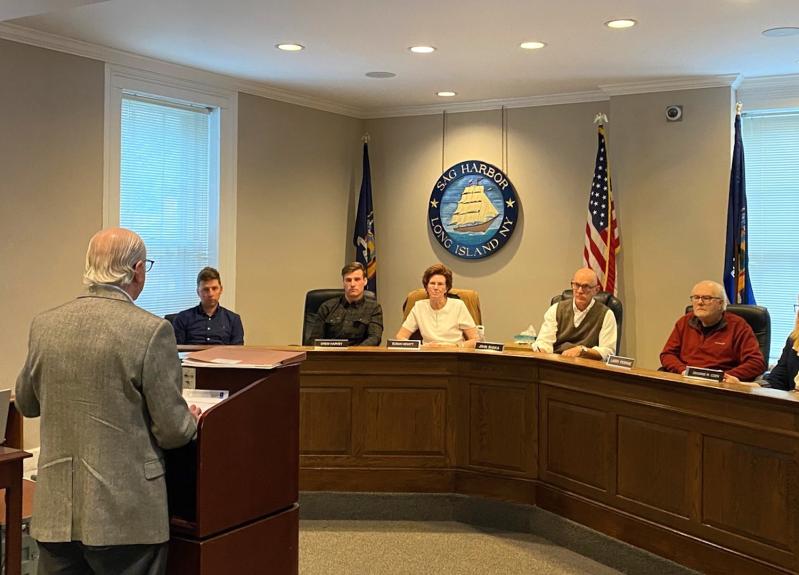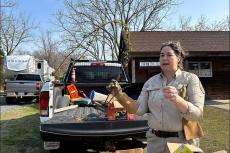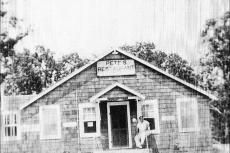A hearing Tuesday on the draft environmental impact statement for the 81,257-square-foot building Adam Potter is planning in Sag Harbor drew a number of critics, but also several supporters who spoke of the urgency of affordable housing.
The mixed-use development at a .95-acre parcel at 7 and 11 Bridge Street would replace an existing one-story commercial building and 1.5-story house with a three-story building with 28 market-rate apartments and 20 work-force housing apartments, 8,576 square feet of service-oriented commercial space, and a 16,554-square-foot internal parking garage. Mr. Potter proposes 134 parking spaces, 41 of them on site and 93 on adjacent property at 5 Bridge Street.
The proposed 35-foot-tall building would be in the village office, waterfront overlay, historic overlay, and tidal flood hazard overlay districts.
Special-exception approval is required to allow apartments in the office district and a structure greater than 3,500 square feet in the waterfront overlay district. The proposal also requires variances including maximum residential unit density, maximum number of stories, minimum rear yard, allowance for offsite parking, allowance for enclosed areas below base flood elevation, and relief from development standards for the parking at 5 Bridge Street.
The developer has also applied to New York State for the cleanup of the property as a potential Brownfields site, at which environmental contamination may complicate expansion, redevelopment, or reuse of a property. The lots on which Mr. Potter wants to build were previously part of a Superfund site, as designated by the federal Environmental Protection Agency, that is administered by National Grid. An environmental easement constrains the property so that the utility company can fulfill its requirements of a site management plan, negotiated with the New York State Department of Environmental Conservation.
The draft environmental impact statement was required because of the April 2024 determination that the proposed development could have a significant environmental impact on the constrained site. The planning board voted unanimously last month to deem the D.E.I.S. complete in order to initiate a public review.
That determination did not mean that the board agreed with the applicant’s conclusions, John Ellsworth of the Nelson, Pope & Voorhis engineering firm emphasized. In fact, he said, the board’s resolution to assess the D.E.I.S. as complete identified issues not yet resolved and needing further analysis. The planning board will base its ultimate decisions on a final environmental impact statement, over which it will have final authority.
Nine people spoke Tuesday night at the village planning board’s hearing on the D.E.I.S. Critics included representatives of Save Sag Harbor, who pointed to flooding, parking, traffic, and contamination from incomplete environmental remediation at the site.
Jeff Bragman, an attorney representing Save Sag Harbor, had little positive to say about Mr. Potter’s proposal. The proposed structure is “almost lot line to lot line,” with coverage around 2 percent less than the maximum allowable, he said. “The lot area is clearly not sufficient, appropriate, or adequate for this project.”
Of the variance sought for enclosed areas below base flood elevation, “that’s the most basic restraint on building to keep you out of the way of floods,” Mr. Bragman said, adding that the applicant proposes to “waterproof up to eight feet — I don’t know how you do that with windows, doors, and seepage, but that’s what they’re doing. . . . They give a nod to climate change and Superstorm Sandy . . . but no attempt is made to indicate any mitigation of these problems. In fact, what they quote is, ‘the village needs to upgrade the infrastructure.’ I call that the ‘not my job’ philosophy of impact mitigation.”
The proposed structure, which Mr. Potter hopes to connect to the village’s sewer system, would generate more than 11,000 gallons of flow per day, Mr. Bragman continued. “We have no data on that yet. This is evolving on the outside of this hearing. . . . I believe it’s segmentation to leave that out.”
The parking on the site is also inadequate, he said, “and in taking over the [5] Bridge Street site,” where public parking currently exists, “they’re going to reduce parking.” The applicant’s assertion that he can build to near-maximum coverage, add 48 housing units and 8,500 square feet of commercial space, “and take away 93 parking spaces that now belong to the public, and guess what, the traffic report says there’s going to be no impact on traffic — it’s ludicrous,” Mr. Bragman said.
Other speakers complained about pile driving to install foundations and the potential for damage resulting from vibrations; an estimated 172 truck trips over almost 18 months of construction, light trespass, and obstructed views caused by the 35-foot building. “This is going to be a concrete jungle,” said Paula Raflo, predicting air pollution, noise pollution, “every kind of pollution I can think of.” It “should be out of the question, that this should be allowed.”
But Kateryna and Yevhenii Surovets were among those speaking in favor of the proposal. Both said that State Department of Environmental Conservation oversight of environmental remediation would ensure it is done properly. It would enable people to live close to their workplace, Ms. Surovets said, while Mr. Surovets said that “affordable housing is so needed here. It is so expensive to live here.”
A third speaker cited the same issues in voicing support, but proponents of the plan were outnumbered by those who were decidedly skeptical.
The meeting was briefly disrupted by a “Zoom bomb,” in which pornography was shown on monitors in the meeting room. Several people participating via Zoom video conference were thought to have left the meeting at that point, and between that incident and the request by several speakers that the hearing be kept open, “I suggest we vote on keeping open the public hearing and tabling this item until next month,” John Shaka, the board’s chairman, told his colleagues. The board will accept public comment until June 27.




